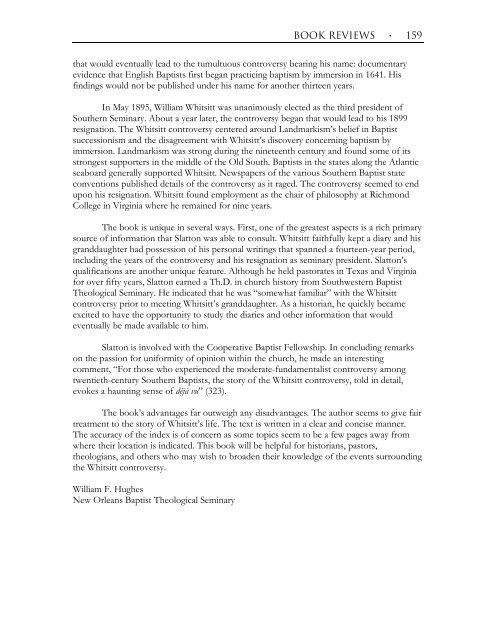0 jbtm vol. 6, no. 2 the proclamation of the gospel - Baptist Center for ...
0 jbtm vol. 6, no. 2 the proclamation of the gospel - Baptist Center for ...
0 jbtm vol. 6, no. 2 the proclamation of the gospel - Baptist Center for ...
You also want an ePaper? Increase the reach of your titles
YUMPU automatically turns print PDFs into web optimized ePapers that Google loves.
BOOK REVIEWS ٠ 159<br />
that would eventually lead to <strong>the</strong> tumultuous controversy bearing his name: documentary<br />
evidence that English <strong>Baptist</strong>s first began practicing baptism by immersion in 1641. His<br />
findings would <strong>no</strong>t be published under his name <strong>for</strong> a<strong>no</strong><strong>the</strong>r thirteen years.<br />
In May 1895, William Whitsitt was unanimously elected as <strong>the</strong> third president <strong>of</strong><br />
Sou<strong>the</strong>rn Seminary. About a year later, <strong>the</strong> controversy began that would lead to his 1899<br />
resignation. The Whitsitt controversy centered around Landmarkism’s belief in <strong>Baptist</strong><br />
successionism and <strong>the</strong> disagreement with Whitsitt’s discovery concerning baptism by<br />
immersion. Landmarkism was strong during <strong>the</strong> nineteenth century and found some <strong>of</strong> its<br />
strongest supporters in <strong>the</strong> middle <strong>of</strong> <strong>the</strong> Old South. <strong>Baptist</strong>s in <strong>the</strong> states along <strong>the</strong> Atlantic<br />
seaboard generally supported Whitsitt. Newspapers <strong>of</strong> <strong>the</strong> various Sou<strong>the</strong>rn <strong>Baptist</strong> state<br />
conventions published details <strong>of</strong> <strong>the</strong> controversy as it raged. The controversy seemed to end<br />
upon his resignation. Whitsitt found employment as <strong>the</strong> chair <strong>of</strong> philosophy at Richmond<br />
College in Virginia where he remained <strong>for</strong> nine years.<br />
The book is unique in several ways. First, one <strong>of</strong> <strong>the</strong> greatest aspects is a rich primary<br />
source <strong>of</strong> in<strong>for</strong>mation that Slatton was able to consult. Whitsitt faithfully kept a diary and his<br />
granddaughter had possession <strong>of</strong> his personal writings that spanned a fourteen-year period,<br />
including <strong>the</strong> years <strong>of</strong> <strong>the</strong> controversy and his resignation as seminary president. Slatton’s<br />
qualifications are a<strong>no</strong><strong>the</strong>r unique feature. Although he held pastorates in Texas and Virginia<br />
<strong>for</strong> over fifty years, Slatton earned a Th.D. in church history from Southwestern <strong>Baptist</strong><br />
Theological Seminary. He indicated that he was “somewhat familiar” with <strong>the</strong> Whitsitt<br />
controversy prior to meeting Whitsitt’s granddaughter. As a historian, he quickly became<br />
excited to have <strong>the</strong> opportunity to study <strong>the</strong> diaries and o<strong>the</strong>r in<strong>for</strong>mation that would<br />
eventually be made available to him.<br />
Slatton is in<strong>vol</strong>ved with <strong>the</strong> Cooperative <strong>Baptist</strong> Fellowship. In concluding remarks<br />
on <strong>the</strong> passion <strong>for</strong> uni<strong>for</strong>mity <strong>of</strong> opinion within <strong>the</strong> church, he made an interesting<br />
comment, “For those who experienced <strong>the</strong> moderate-fundamentalist controversy among<br />
twentieth-century Sou<strong>the</strong>rn <strong>Baptist</strong>s, <strong>the</strong> story <strong>of</strong> <strong>the</strong> Whitsitt controversy, told in detail,<br />
evokes a haunting sense <strong>of</strong> déjà vu” (323).<br />
The book’s advantages far outweigh any disadvantages. The author seems to give fair<br />
treatment to <strong>the</strong> story <strong>of</strong> Whitsitt’s life. The text is written in a clear and concise manner.<br />
The accuracy <strong>of</strong> <strong>the</strong> index is <strong>of</strong> concern as some topics seem to be a few pages away from<br />
where <strong>the</strong>ir location is indicated. This book will be helpful <strong>for</strong> historians, pastors,<br />
<strong>the</strong>ologians, and o<strong>the</strong>rs who may wish to broaden <strong>the</strong>ir k<strong>no</strong>wledge <strong>of</strong> <strong>the</strong> events surrounding<br />
<strong>the</strong> Whitsitt controversy.<br />
William F. Hughes<br />
New Orleans <strong>Baptist</strong> Theological Seminary


